The Demography of Canada and the United States from the 1980s to the 2000s A Summary of Changes and a Statistical Assessment
- PMID: 24032004
- PMCID: PMC3768295
- DOI: 10.3917/pope.1202.0177
The Demography of Canada and the United States from the 1980s to the 2000s A Summary of Changes and a Statistical Assessment
Abstract
Canada and the United States have enjoyed vigorous population growth since the early 1980s. Although mortality is slightly higher in the United States than in Canada, this is largely offset by much higher fertility, with a total fertility rate at replacement level, compared with just 1.5 children per woman in Canada. The United States is also the world's largest immigrant receiving country, although its immigration rate is only half that of Canada, where today one person in five is foreign-born, versus one in eight in the United States. Based on recent trends in fertility, mortality and international migration, the populations of these two North American countries will continue to grow over the next five decades, but at a progressively slower pace. The most acute demographic issue today is not, as in Europe, that of imminent population decline, but rather of the geographic and social inequalities which have increased steadily since the early 1980s and which are reflected in major fertility and health differentials between regions and social groups.
Keywords: Canada; North America; United States; demographic ageing; demographic history; demographic projections; demographic situation; fertility; migration; mortality; nuptiality.
Figures
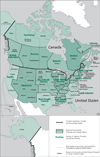

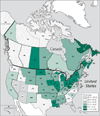






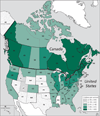




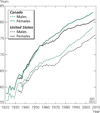
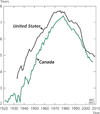



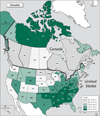






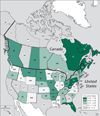

Similar articles
-
Immigrant and native fertility during the 1980s: adaptation and expectations for the future.Int Migr Rev. 1994 Fall;28(3):501-19. Int Migr Rev. 1994. PMID: 12345792
-
Immigrant fertility: an examination of social characteristics and assimilation.Sociol Focus. 1992 Feb;25(1):27-38. doi: 10.1080/00380237.1992.10570605. Sociol Focus. 1992. PMID: 12285967
-
Migration from Latin American countries to the United States: the economic, social and reproductive lives of Hispanic female immigrants, 1980.Int Migr. 1991 Dec;29(4):573-99. doi: 10.1111/j.1468-2435.1991.tb01041.x. Int Migr. 1991. PMID: 12159612
-
Trends in fertility and intermarriage among immigrant populations in Western Europe as measures of integration.J Biosoc Sci. 1994 Jan;26(1):107-36. doi: 10.1017/s0021932000021106. J Biosoc Sci. 1994. PMID: 8200876
-
Black demographic trends in the 1980s.Milbank Q. 1987;65 Suppl 1:35-55. Milbank Q. 1987. PMID: 3327008 Review.
Cited by
-
The human impact on North American erosion, sediment transfer, and storage in a geologic context.Nat Commun. 2020 Nov 26;11(1):6012. doi: 10.1038/s41467-020-19744-3. Nat Commun. 2020. PMID: 33243971 Free PMC article.
-
Modal lifespan and disparity at older ages by leading causes of death: a Canada-U.S. comparison.J Popul Res (Canberra). 2020;37(4):323-344. doi: 10.1007/s12546-020-09247-9. Epub 2020 Nov 5. J Popul Res (Canberra). 2020. PMID: 33269014 Free PMC article.
-
Declining regional disparities in mortality in the context of persisting large inequalities in economic conditions: the case of Germany.Int J Epidemiol. 2020 Apr 1;49(2):486-496. doi: 10.1093/ije/dyz265. Int J Epidemiol. 2020. PMID: 31977053 Free PMC article.
-
Costly children: the motivations for parental investment in children in a low fertility context.Genus. 2021;77(1):6. doi: 10.1186/s41118-020-00111-5. Epub 2021 Feb 17. Genus. 2021. PMID: 33678812 Free PMC article.
References
-
- Adams O. Health Reports. 4. Vol. 2. Statistics Canada: 1990. “Life expectancy in Canada: an overview”; pp. 361–376. - PubMed
-
- Adveev A, Eremenko T, Festy P, Gaymu J, Le Bouteillec N, Springer S. “Populations and demographic trends of European countries, 1980–2010”. Population, English Edition. 2011;66(1):9–130. http://www.ined.fr/fichier/t_publication/1552/publi_pdf2_04_pope1101_avd...
-
- Ananth CV, Liu S, Joseph KS, Kramer MS. “A comparison of foetal and infant mortality in the United States and Canada”. International Journal of Epidemiology. 2009;38:480–489. - PubMed
-
- Anderton DL, Barrett RE, Bogue DJ. The Population of the United States. New York: The Free Press; 1997. p. 693.
-
- Arias E. National Vital Statistics Reports. 9. Vol. 59. National Center for Health Statistics; 2011. “United States life tables, 2007”; p. 60. http://www.cdc.gov/nchs/data/nvsr/nvsr59/nvsr59_09.pdf. - PubMed
Grants and funding
LinkOut - more resources
Full Text Sources
